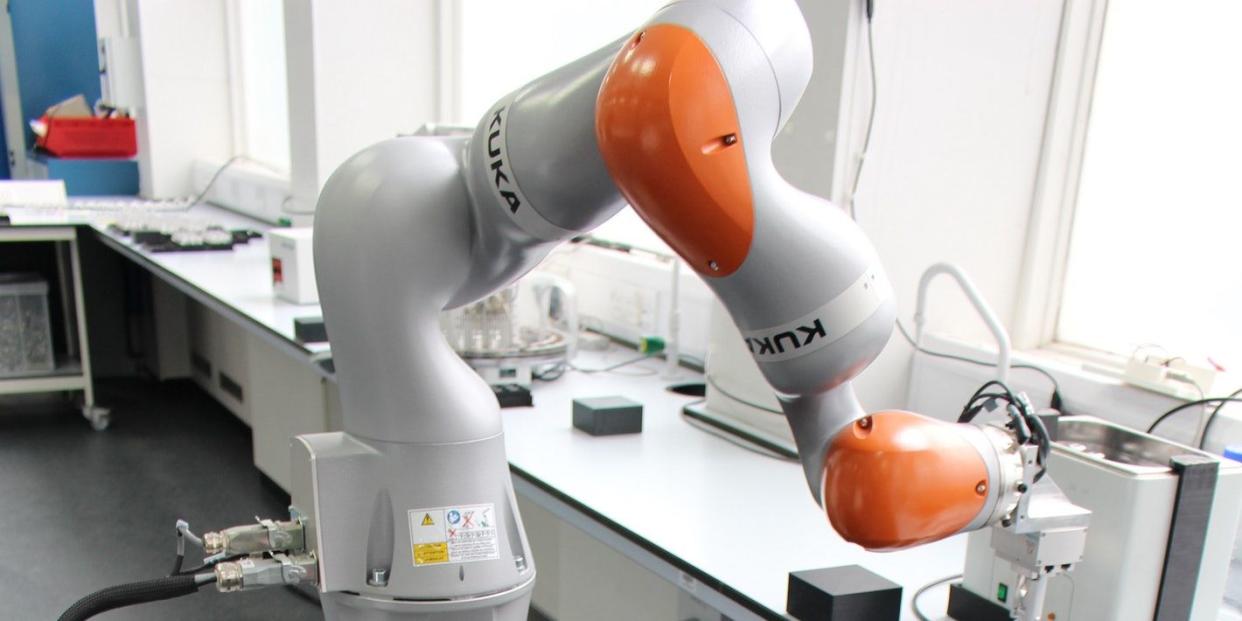This Robot Did 700 Chemistry Experiments in Just 8 Days

A new autonomous chemistry robot works on complex experiments without management.
Powerful computers can narrow down huge pools of candidates and parameters, in this case finding an exciting new photocatalyst.
The humanoid robot can use the same instruments as humans, freeing them to do big picture science.
The University of Liverpool's new lab assistant works 1,000 times faster that any chemist that's come before it—it's also a robot. But rather than replace other humans, its creators believe it can help to do repetitive work and computing that will free scientists to do more big picture tasks.
The currently unnamed robot is humanoid but without overtly human-style arms, legs, and face, because it simply doesn’t need those things. These missing human parts is a feature—not a flaw—because it allows the robot to work at the lab bench and with other equipment designed for standing humans to use. The robot uses lasers and touch sensors to interact with the workspace.
In a way, the robot combines the best parts of a computer to tackle scientists' most time-consuming tasks. A robot can pipette individual drops for twenty experiments while processing batch data like potential candidate ingredients for a catalyst.
New technology and research into robots can end up focused on very anthropomorphic qualities and even so-called “thinking like a human,” but neither of those things is an inherent strength of a computing machine. The human brain is already extremely capable of synthesizing high-level information and thinking in associative, abstract ways that bring forth new ideas. What we can use help with is blunt-force sorting of 5,000,000 chemicals into ones that have a certain desired quality and ones that don’t.
And this is where the Liverpudlian robot excels. By design, it combines repetitive tasks of many different kinds with powerful electronic reasoning. That’s a huge change from existing, relied-upon automated lab tools that usually performs only one task. Because of its special combination of gifts, this robot was uniquely prepared to take on a very contemporary problem.
Researchers set out a series of parameters that would both use the robot’s strengths and highlight how difficult some tasks have been for previous robots. “Robots can assist in experimental searches, but their widespread adoption in materials research is challenging because of the diversity of sample types, operations, instruments and measurements required. Here we use a mobile robot to search for improved photocatalysts for hydrogen production from water,” they explain in their paper.
With an overall limit of 10 possible variables, the robot operated on its own for eight days and completed nearly 700 experiments. The robot narrows down parameters and candidates using a Bayesian search algorithm, which typically means starting with a weighted metric of what is most likely to succeed and ruling that out first.
At the end of eight days, the robot had a photocatalyst six times better than what human researchers had put together. Inverse reports that the researchers believe this approach is more valuable than ever when labs are making arrangements to work from home or socially distance.
Other powerful AIs have discovered new candidates for antibiotics and medications as part of the same kind of analysis. Attach that level of computing to a free-roaming robot with lab access, and we could have the next vaccine candidate to fight coronavirus.
You Might Also Like

